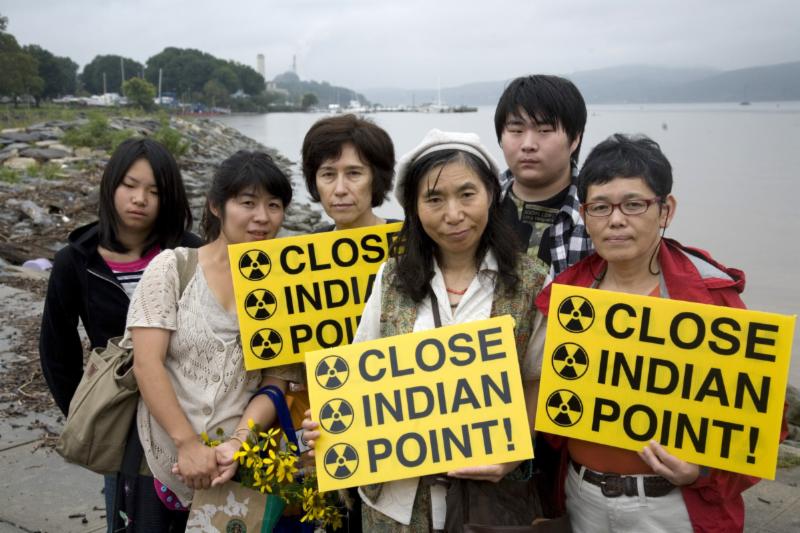Radioactive waste documentary "Containment" premieres on PBS, Mon., Jan. 9, 10pm Eastern
How can we contain some of the deadliest, most long-lasting substances ever produced?
Toxic remnants from the Cold War remain in millions of gallons of highly radioactive sludge, thousands of acres of radioactive land, tens of thousands of unused hot buildings, and
some slowly spreading deltas of contaminated groundwater.
Governments around the world, desperate to protect future generations, have begun imagining society 10,000 years from now in order to create warning monuments that will speak across time to mark waste repositories.
Containment
moves from a nuclear weapon facility in South Carolina where toxic swamps have led to radioactive animals, to a deep underground burial site in New Mexico, to Fukushima, Japan, where a triple meltdown occurred after the cooling systems at the Daiichi Nuclear Power Plant were interrupted, leaving that city a ghost town. The film is part graphic novel and part observational essay mixed with sci-fi that is more science than fiction, weaving between an uneasy present and an imaginative, troubled distant future, exploring the struggle to keep waste confined over millennia.
Beyond Nuclear was honored and privileged to serve in an advisory role for this film by Peter Galison & Robb Moss, and is thankful to have had a short interview included, alongside those of numerous colleagues. (Be sure to
check your local listings to make sure your local PBS channel is showing it.
More.)
|

"Day Against Denial" Actions (Mon., Jan. 9), and Resisting Trump's Corporate Cabinet
Beyond Nuclear has joined in coalition with such partners as Climate Reality Check, 350.org, and FOE in a nationwide "Day Against Denial" actions on Mon., Jan. 9, and with Food & Water Watch on blocking President-elect Trump's dirty, dangerous and expensive energy industry Cabinet nominees.
Beyond Nuclear has published an exposé on former Texas governor Rick Perry's blatant conflict of interest involving the Waste Control Specialists radioactive waste dump in Andrews County, Texas, that disqualifies him from serving as Energy Secretary. Please phone your two U.S. Senators via the Capitol Switchboard at (202) 224-3121, and urge them to block Perry's confirmation.
With Trump's inauguration fast approaching, Beyond Nuclear has joined in solidarity with allies for social justice, the environment, and other progressive causes, to endorse and take part in the Women's March on Washington on Jan. 21st, the complementary #We Rise - Jan. 21 Teach-In, and AFSC's Jan. 22nd "Challenging Trumpism, Wars, and Militarism" conference, all taking place in Washington, D.C. Please come to participate if you can, and spread the word!
|

Entergy's Indian Point nuclear power plant to close by 2020-2021
New York Governor Andrew Cuomo may announce early this week a widely reported, but yet to be confirmed, agreement between his office, Entergy, NY Attorney General Schneiderman, and Riverkeeper, Inc. to permanently shut down the Indian Point Units 2 & 3 atomic reactors by April 2020 and April 2021, respectively. (See photo, above right, of a Japanese delegation, sponsored by Beyond Nuclear, including Fukushima nuclear catastrophe survivors and anti-nuclear activists, with Indian Point in the background, September, 2011.)
However, an escape clause allowing four more years of operations (till 2024 and 2025) could be invoked, if replacement electricity can't be provided for in time. This raises alarm bells, given the efforts by both the nuclear power industry as well as the fossil fuels industries, to regularly attempt to sabotage the ready promise of renewables and efficiency.
Even three to four (let alone seven to eight) more years of operations at Indian Point is very risky. Consider the report, commissioned by Riverkeeper, Inc., and written by Dr. Ed Lyman of UCS on the third anniversary of the 9/11 attacks, entitled
"Chernobyl on the Hudson? The Health and Economic Impacts of a Terrorist Attack at the Indian Point Nuclear Plant." Using government computer models, Dr. Lyman calculated that "depending on the weather conditions, an attack could result in as many as 44,000 near-term deaths from acute radiation syndrome or as many as 518,000 long-term deaths from cancer among individuals within 50 miles of the plant." (More than 17 million people live or work within a 50-mile radius of Indian Point.)
Dr. Lyman estimated property damages could range from $1 to 2 trillion (yes, with a T!), and that "Millions of people would require permanent relocation."
Of course, a "mere accident," as due to age-related degradation (there have been a large number of breakdowns at the four-decade old reactors), or a natural disaster, could also unleash such a radioactive catastrophe. A U.S. Nuclear Regulatory Commission report has listed Indian Point as the most vulnerable nuclear power plant in the U.S. to an earthquake. Fault lines were discovered very near Indian Point in recent years.
Also, each year of operations at Indian Point kills a billion fish and other aquatic life in the Hudson River, due to the reactors' once-through cooling system. And annually, around 40 tons of additional high-level radioactive waste is generated there. Indian Point's irradiated nuclear fuel pools have been leaking, into the soil, groundwater, and Hudson River, for years, even decades.
More, including
media coverage.
|
Thank you for joining us in working for a nuclear-free world. Please consider
making a donation to Beyond Nuclear and sharing our posts with your friends and colleagues. And follow us on
Facebook and
Twitter!
All best wishes,
The Beyond Nuclear team
|
|
|
|
|
Copyright © 2013. All Rights Reserved.
|
|
|
|